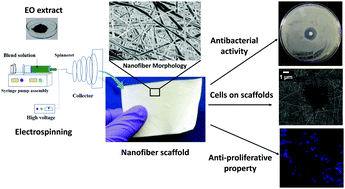Emblica officinalis-loaded poly(ε-caprolactone) electrospun nanofiber scaffold as potential antibacterial and anticancer deployable patch†
Abstract
Biological functions of nanofiber scaffolds can be engineered via the incorporation of plant extracts. In the present study, Emblica officinalis (EO) (Indian Gooseberry known as amla)-loaded poly(ε-caprolactone) (PCL) nanofibers were prepared via the electrospinning technique. The aim was to prepare nanofiber scaffolds with antibacterial and anti-cancerous properties. The scaffolds were characterized via SEM, XRD, small-angle X-ray scattering, FTIR spectroscopy, streaming potential, DSC, water contact angle and tensile measurements. Upon the incorporation of EO, the nanofiber surface became rougher and exhibited a ‘braid-like’ morphology. This is in contrast to the pristine PCL nanofibers, which exhibited a smooth fiber surface. The average fiber diameter increased, and the water contact angle of the nanofiber scaffolds decreased with an increase in the EO content in PCL. The crystalline structure of PCL was not affected; however, its crystallization temperature increased significantly and its melting temperature increased marginally with the addition of EO. The PCL scaffold showed a negatively charged surface and its ξ-potential increased with an increase in EO content due to the presence of various functional groups. The antibacterial studies revealed that the PCL–EO nanofiber scaffolds exhibited efficient antibacterial properties against both Gram-positive and Gram-negative bacterial strains and the zone of inhibition increased with EO content. Furthermore, cellular behavior of MCF-7 cells was studied using the MTT assay, fluorescent staining and SEM, which indicated that cell proliferation was significantly inhibited by the incorporation of EO in the scaffolds.



 Please wait while we load your content...
Please wait while we load your content...